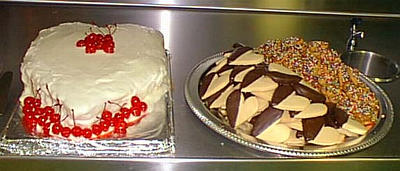14 February, 1999
February 14, 1999 -- Happy Valentine’s Day from the Nathaniel B. Palmer!
We sure had a nice surprise for Valentine’s Day today -- heart shaped cookies
and a heart shaped cake! By the time dinner was over, they were pretty much
demolished . . . but they sure tasted great! Today we spent a lot of time
working on our multibeam survey in the Ross Sea. We also took one core of mud
from the ocean bottom. Throughout our 12 hour shift, in addition to doing
things like coring, we also have other responsibilities. For starters, we
keep
a log book of all the important data (latitude, longitude, direction we are
traveling, speed of the ship, depth of the water, and specific instrument
readings) every 15 minutes. While we are writing down all of this
information,
we are also checking to make sure that all of the instruments and computers
are
working properly. Yesterday we had some computer problems that needed major
fixing, but today things went fairly well.
We didn’t see the ice shelf today, but I want to follow up on our question
“What is an ice shelf?”. Well, an ice shelf is a large, floating area of ice
that is connected to the land. It is formed from the ice sheet that covers
most of Antarctica. As this ice sheet approaches the sea, it sometimes
extends
from the land into the water. Because it is floating and not touching the
seafloor, it is called an ice shelf.
There are no major ice shelves in the Arctic, but in Antarctica they are
huge.
The largest are in the Ross and Weddell seas. The Ross Ice Shelf, which we
observed yesterday, covers an area larger than the state of Texas! It's
average thickness is 335 to 700 meters, but where the front end faces the Ross
Sea it is closer to 100 meters thick (part of that is below the water level).
As the continental ice sheet moves from the center of Antarctica towards the
sea, icebergs calve off the front of the ice shelf to allow for the new ice
near the shore. This process does not keep the ice shelf at an exact size,
however. According to our observations yesterday, the Ross Ice Shelf seems to
be advancing towards the sea. We were able to personally verify this when we
tried to multibeam a parcticular area on the map. We plotted the way point
(destination) on the map, and gave the latitude and longitude coordinates to
the Mate on the Bridge. As it turns out, the point we gave him was actually
inside the ice shelf! There was no way we could go to that exact location . .
. even though it was open water when the map was originally made!
Not all ice shelves seem to be advancing, however. In fact, most ice shelves
in the Antarctic Peninsula seem to be shrinking. One possible theory is that
this is due to global warming. The Antarctic Peninsula is the northernmost
part of the continent, and therefore it is the warmest. Since the 1940s, the
average temperature in the Antarctic Peninsula has increased by 2.5 degrees
C.
This has weakened the ice shelves in that area. In addition, warmer sea water
may be causing the ice shelves to melt from underneath. As a result, more
than
3000 square miles of ice shelves in the Antarctic Peninsula area have
disappeared in the last 50 years.
It is important to understand that the gradual breakdown of the ice shelves in
the Antarctic Peninsula won't necessarily raise sea levels. If you put an ice
cube in a glass of water, the water level goes up as soon as the ice is
added.
As that ice cube melts, the water level changes very little. Since the ice
shelves are already floating, sea level will not change if they melt. The
only
way sea level would rise due to the gradual disintegration of the Antarctic
Peninsula ice shelves would be if their crumbling caused the ice sheet on top
of the land to discharge more ice. Even in that situation, however, the rest
of the world would feel very little effect. The extra discharge would have to
occur from many parts of the Antarctic Ice Sheet, not just near the Peninsula,
for large changes in sea level to happen.
Before I close for the day, I want to give you something to think about for
tomorrow. Several people have written and asked questions about the ship that
we are on. If you were going to build a ship, what types of things would you
need to think about and include in order for it to be able to conduct
scientific research in Antarctica?
If you have any questions that you would like to ask (or any suggestions for
journal entries or pictures), don’t hesitate to write. We usually receive
email 3 to 4 times a day, although sometimes we don’t receive it at all. Due
to the fact that we are located in a remote location (and sometimes email gets
“lost” in cyberspace), if you send a question and don’t hear an answer within
24 hours or so, please send the question again.
Tune in tomorrow! Kim Giesting
Latitude: 75 degrees 11 minutes South
Longitude: 175 degrees 54 minutes West
Temperature: -3 degrees C
It may seem like we aren’t moving very much if you are following our longitude
and latitude. Remember that we are going back and forth over certain areas of
the Ross Sea to make maps and take cores. Sometimes we may spend up to a week
in one certain area.

Our Valentine's Day goodies! They were great!

This is Broxton writing down information in the log book.
Contact the TEA in the field at
.
If you cannot connect through your browser, copy the
TEA's e-mail address in the "To:" line of
your favorite e-mail package.
|
